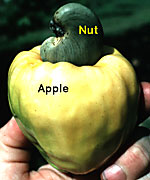


Home
Flowers &
Indoor Plants
Fruits & Nuts
Ornamentals
Vegetables
Special Topics
Resources
Glossary

|
Cashew Anacardium occidentale (An-ah-car-dee-um ox-ih-den-tal-ee) 
 Click on thumbnails for larger image. |
 |
What about it? The cashew is native to the West Indies, Central America, Peru and Brazil, and it is also found in many tropical countries in Africa and Asia. It can reach a height of over 30 feet. The cashew belongs to a family of plants with resinous bark, which also includes mango, pistachio, poison ivy and poison sumac. The shell or skin, as well as the sap of all parts of the tree, contain a caustic oil which irritates our skin in a way similar to poison ivy. What is it used for? The apple-like fruit of the cashew tree can be eaten raw or cooked. The kidney-shaped true fruit is the cashew nut, which must be roasted before shelling to get rid of poisonous oils. Cashew nuts are commonly eaten roasted or used in baking, and are deliciously rich! The nut also yields an excellent-quality oil. Cashew gum is harvested for medicinal or decorative purposes. This gum is said to be an excellent insect repellent. Where does it grow? How do we grow it? The cashew tree will grow in a well-drained soil in tropical climates, and is fairly tolerant of drought conditions after it has become established. It is usually propagated from seed. The cashew needs occasional pruning. What are its primary problems?The young leaves are occasionally attacked by thrips, and fruit flies often are attracted to the fruit. How do we harvest and store it? There is no danger in handling the fruit unless the outer covering has been broken and the oil is being released. Gloves are usually worn in this case. The nut (seed) is removed from the fruit and roasted. After the roasting, the shells are removed. Store the kernels (cashew nuts) in a dry, dark container ...if you can keep them that long without eating them!
© Copyright, Department of Horticulture, Cornell University. |